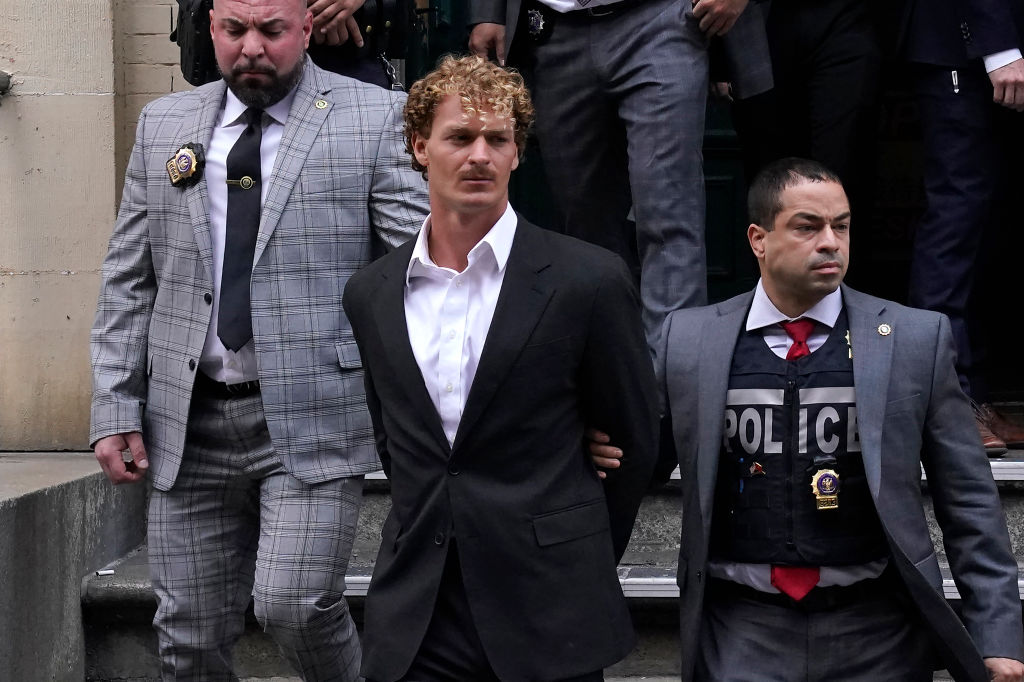Daniel Penny Indicted: Jordan Neely's Chokehold Killer Charged
NYC Grand Jury Indicts Daniel Penny In Chokehold Killing Of Jordan Neely

Source: TIMOTHY A. CLARY / Getty
A grand jury has formally indicted a white man on criminal charges in the vigilante chokehold death of an unarmed Black man on the subway in New York City last month, according to reports.
The New York Daily News cited a law enforcement source when reporting that Daniel Penny was on Wednesday officially charged with second-degree manslaughter for the homicide of Jordan Neely, who was in the throes of a mental health crisis when he was placed in the deadly restraint.
MORE: Jordan Neely And The Lost Lives Of America’s Young, Black And Disabled
Even the right-wing tabloid the New York Post, which has lent sympathetic coverage to Penny, reported that its sources had confirmed the indictment that was reached on Wednesday.
The indictment comes more than a month after Penny, 24, surrendered and was arrested, prompting the Manhattan District Attorney’s Office to refer the case to a grand jury.
The Rev. Al Sharpton, who eulogized Neely at his funeral in Harlem last month, applauded the grand jury indictment while emphasizing that the charges don’t fit the alleged crime.
“The Manhattan grand jury saw right through [Penny’s] false narrative by voting to move this case forward,” Sharpton said in a statement emailed to NewsOne. “While they should be saluted for this righteous step, we wish the charge would have reflected what this really was: murder.”
What happened to Jordan Neely?
Eyewitnesses abroad on the F-line train that fateful day on May 1 claim Neely was acting erratically and yelling that he was hungry and didn’t care if he went to jail. Penny, a former Marine who is trained to kill, is accused of coming up behind Neely and placing him in a chokehold that lasted minutes. With the help of two unidentified men, Penny was able to keep Neely restrained via the chokehold until there was no more life in the 30-year-old’s body.
Penny was arrested on the scene but later released without any criminal charges, sparking an uproar over the lack of accountability for employing deadly force over a perceived physical threat from Neely.
Nearly two full weeks later, Penny and his lawyers were allowed by law enforcement to orchestrate his surrender.
Penny has been doing damage control
Penny has maintained that he never intended to kill Neely and recently doubled down on his claims that race was not a factor when he decided to take the law into his own hands.
In a new interview with Law & Crime, Penny predictably explained that Neely’s verbal threats justified the physical force that ultimately killed him. Penny also downplayed the severity of the chokehold — which caused Neely to die by “compression of the neck,” according to a medical examiner — claiming it wasn’t applied for the amount of time “some people” are saying it was applied for.
He went on to express similar claims about race that he previously made through his lawyer.
“I didn’t see a black man threatening passengers. I saw a man threatening passengers–a lot of whom were people of color. A man who helped restrain Mr. Neely was a person of color,” Penny said.
What about the men who aided and abetted Penny?
Little has been said about the two men who actively assisted Penny by helping to restrain Neely, likely increasing the prospects of death. Penny said in his Law & Crime interview that one of the men was a “person of color.” But aside from that fleeting, if not irrelevant reference, neither of the two men shown on video of Penny choking Neely to death has been mentioned to the media by law enforcement.
The widely shared video from inside the subway car begins with the chokehold already fully underway as another man is shown holding down both of Neely’s arms. A second man is shown standing over them as Neely struggles, prompting the chokehold to appear to get even tighter. That’s when the man standing over them reaches down to push down Neely’s right shoulder, making it more conducive for the chokehold Neely was trying to escape.
To be sure, neither man ever attempted to stop Penny or help Neely.
After it became apparent that Neely was no longer moving, the third man who held down Neely finally stood up.
But the second man who had been holding down Neely all along appeared to continue to apply pressure to what was likely already a lifeless body. Penny similarly did not let up.
And that’s where the video, and presumably Neely’s life, ended.
NYC grand juries don’t always guarantee indictments
The law enforcement response to this case has been less than desired, according to critics who have pointed to the NYPD for not arresting Penny when they had the chance to in the hours after he killed Neely. But Manhattan District Attorney Alvin Bragg similarly invited scorn when he initially appeared noncommittal on the case in a response that allowed Penny the privilege of getting all his legal and personal affairs in order before he surrendered to the police on his own terms. Bragg did himself no favors, either, by declining to charge Penny and instead referring the decision to a grand jury.
But grand juries in New York City have a checkered past when it comes to cases involving vigilante violence on a subway as well as a chokehold death, both hallmarks of the allegations against Penny.
Notably, in the case of Bernhard Goetz, after the white man was charged with four counts of attempted murder for shooting four young Black men at close range on a train in 1984, a grand jury quickly declined to indict the so-called “subway vigilante” on those same charges. Instead, Goetz was only charged with criminal possession of the gun he used to shoot the teens. Another grand jury was empaneled after more evidence was presented and decided to uphold the attempted murder charges. But a judge quickly dismissed those charges by casting doubt on the shooting victims. After an extensive appeal process, including one court upholding a judge’s move to dismiss the charges, the attempted murder charges were finally reinstated. Nearly three years after the subway shooting, Goetz was acquitted of the attempted murder charges and found guilty of the gun charge.
And in the case of Eric Garner — the unarmed Black man choked to death on video in 2014 by a throng of NYPD officers trying to arrest him for the suspicion of selling loose and untaxed cigarettes, a nonviolent misdemeanor offense — a Staten Island grand jury declined to bring any criminal charges at all. The Department of Justice even opened up its own investigation before deciding against bringing federal charges against NYPD Officer Daniel Pantaleo, the ringleader of the police mob that attacked Garner.
This is America.
SEE ALSO:
Jordan Neely Killing: Daniel Penny Says He’s Not Racist Because He Was Helped By POC On NYC Subway
Donors Rush To Thank Daniel Penny For Killing Jordan Neely As Online Fundraiser Generates Millions
















